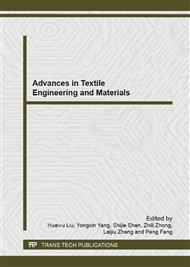p.279
p.283
p.288
p.293
p.298
p.302
p.307
p.312
p.317
Hairiness Analysis between Solospun and Ring Spun Yarns
Abstract:
In this paper, the hairiness relationship between Solospun and Ring Spun yarns is investigated using a geometric method which is different from Cheng et al. It is also analyzed why Solospun yarns have less hairiness than Ring Spun yarns. Then, the relationship between the increase of the substrands number and the decrease of the hairiness during the Solospun is confirmed. Finally, the conclusions of the theoretical analysis are proved by test.
Info:
Periodical:
Pages:
298-301
Citation:
Online since:
December 2012
Authors:
Keywords:
Price:
Сopyright:
© 2013 Trans Tech Publications Ltd. All Rights Reserved
Share:
Citation:


